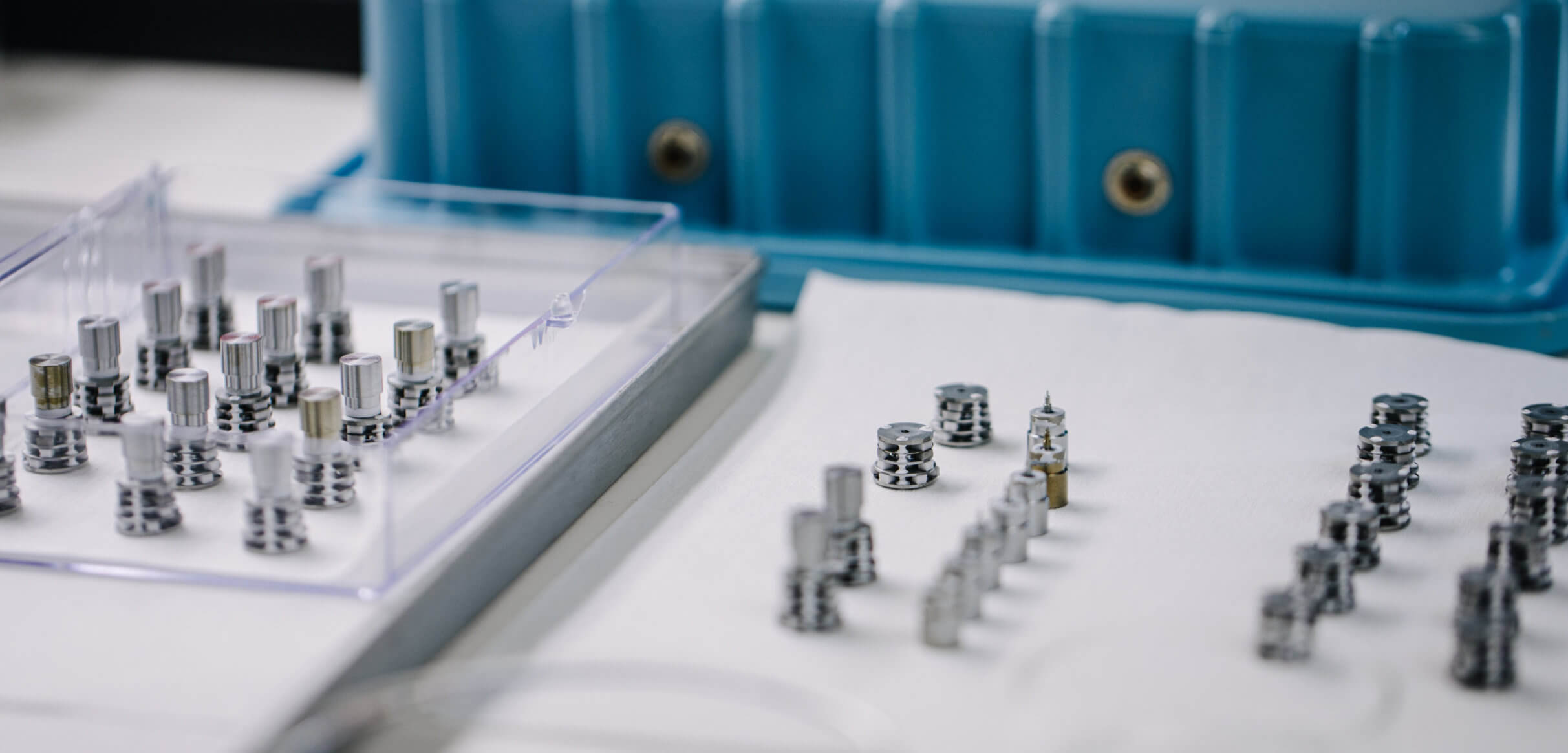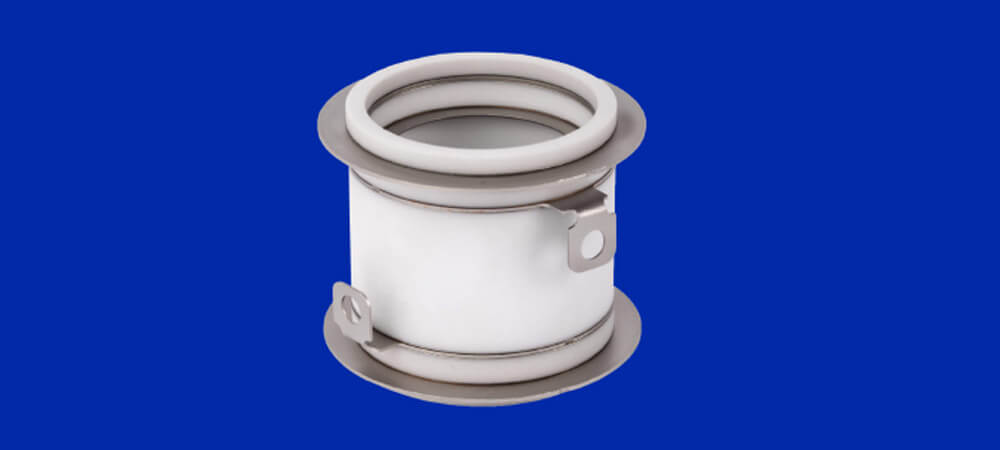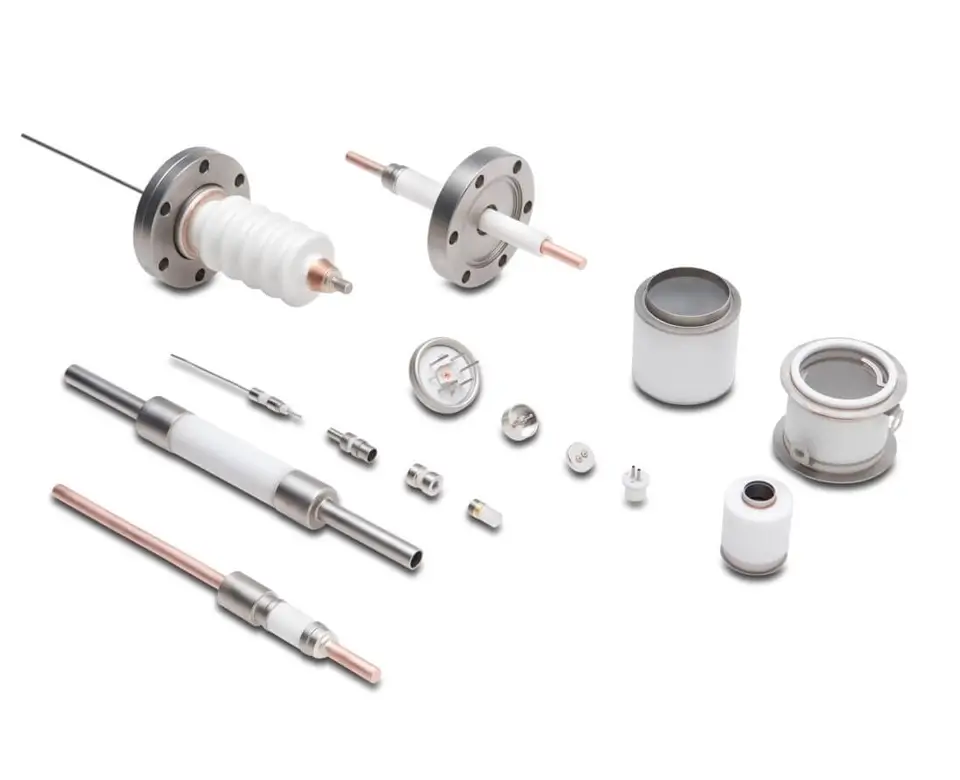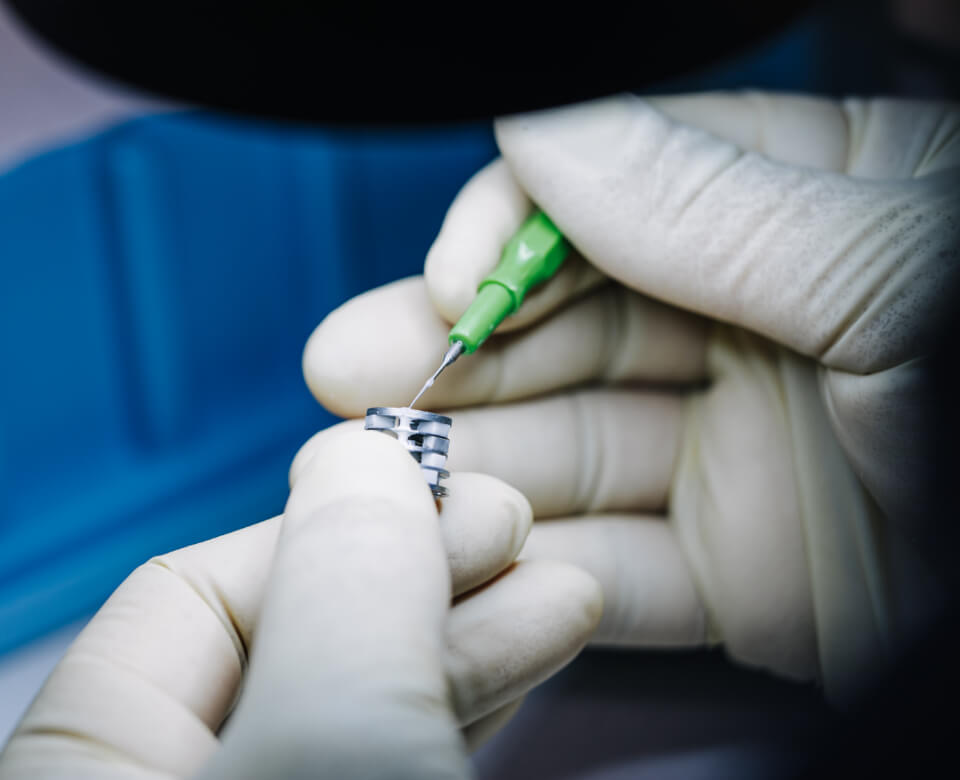In high-stakes industries like aerospace, medical, and defense, maintaining airtight and leak-proof seals is essential for the safety, performance, and longevity of critical equipment and devices.
Any leakage has the potential to compromise the functionality and reliability of these critical systems, so hermetic brazing helps ensure leak-tight seals and maintains performance and integrity.
Leaders in hermetic brazing, Elcon Precision has built a reputation for delivering high-quality, precision-sealed components that perform in even the harshest environments. With specialized in-house metallizing, plating, glazing, and machining, we reduce lead times while ensuring quality with minimal part-to-part variation.
In this article, we explore the hermetic brazing process, as well as some of the common challenges, solutions, and applications.
Understanding Hermetic Brazing
Brazing is a specialized metal to metal or ceramic to metal joining process used to achieve hermetic sealing, which ensures completely leak-tight and airtight seals in critical applications.
This technique involves joining components using a filler metal that melts at a lower temperature than the base materials. The components are precisely heated during the process, allowing the filler metal to flow and bond the parts together. Hermetic brazing is particularly effective in addressing issues related to thermal expansion, as the materials and filler metals, as well as epoxy resins, are carefully selected to minimize stresses caused by temperature variations.
This advanced joining process is essential for creating compression seals that maintain integrity under extreme environmental conditions and is the chosen process for industries like aerospace, medical, and defense, where maintaining the utmost seal integrity is vital for the safety, performance, and reliability of complex systems and devices.
Steps in the Hermetic Brazing Process
- Material Selection: The first step in hermetic brazing is selecting appropriate materials for both the base components and the filler metal. The materials must be compatible to ensure a strong hermetic bond and should have similar thermal expansion coefficients to minimize stress. For applications requiring hermetic seals, materials like stainless steel, Kovar, and ceramics are commonly chosen due to their brazing compatability.
- Joint Design: The design of the joint is crucial for achieving reliable hermetic seals. The joint design should facilitate the proper flow of the filler metal and provide adequate surface area for bonding. Attention to detail in joint design helps ensure the strength and durability of the seal, especially in applications involving sapphire-to-metal seals.
- Cleaning and Preparation: Before brazing, all components must be thoroughly cleaned to remove any contaminants that could impede the bonding process. Proper cleaning ensures the filler metal can wet the surfaces effectively, leading to a strong, leak-tight seal.
- Assembly and Fixturing: The components are assembled and held in place using fixtures. Accurate alignment is essential to ensure the filler metal flows evenly and creates a uniform bond.
- Brazing Atmosphere: The brazing process is typically conducted in a controlled atmosphere, such as a high vacuum or an inert gas environment, to prevent oxidation and contamination. This controlled environment is critical for achieving high-quality, defect-free hermetic seals.
- Temperature Control: Precise temperature control is vital in the brazing process. The components are heated to a specific temperature, at which point the filler metal melts and flows into the joint. Careful control of heating and cooling rates helps prevent thermal shock and ensures a robust, hermetic bond without cracks
-
Common Challenges in Hermetic Brazing
With the need for precise control over several critical factors, the hermetic brazing process can deliver several challenges for manufacturers. Ensuring a contaminant-free environment is essential, as even minor impurities can compromise the quality of the seal. The process also requires careful selection of compatible materials and filler metals, especially when joining dissimilar materials with different thermal expansion rates. Maintaining exact temperature control throughout the brazing process is also vital to avoid defects such as bubbles or voids in the joint and ensure a strong, leak-tight seal.
Surface Contamination
Surface contamination is a significant challenge in hermetic brazing, as even minor impurities can severely affect the quality of the brazed joint. Contaminants such as oils, oxides, and residues prevent proper wetting and bonding of the filler metal to the base materials, leading to weak or incomplete joints. This compromises the hermeticity of the seal, allowing leaks that can undermine the reliability and performance of critical components. Contaminants can also cause voids and inclusions in the brazed joint, reducing its mechanical strength and potentially leading to premature failure in high-stress or demanding applications.
Bubbles in Brazed Joints
Improper temperature control and brazing methods can lead to the formation of bubbles in brazed joints, compromising the integrity of the seal. If the temperature is not precisely controlled, the filler metal may not flow evenly, trapping gasses and creating voids within the joint. These bubbles weaken the mechanical strength of the bond and can create pathways for leaks, undermining the hermeticity of the seal. In applications for industries like aerospace or medical devices, these imperfections can lead to failures, making it critical to maintain accurate temperature settings and employ proper brazing techniques to ensure a reliable, leak-tight joint.
Poor Joint Fit-up
Poor joint fit-up is a significant challenge in brazing, as it directly impacts the capillary action necessary for the filler metal to flow and bond effectively. Precise component machining is crucial to ensure that the parts fit together tightly and uniformly, allowing the filler metal to be drawn into the joint by capillary action. When the joint fit-up is poor, gaps and misalignments occur, disrupting this capillary action and leading to incomplete or weak bonds. This compromises the overall joint quality, resulting in reduced mechanical strength and potential leaks, which are especially problematic in applications requiring hermetic seals.
Material Compatibility
Due to differential expansion rates of metal and filler materials, joining dissimilar materials with hermetic brazing poses a unique set of challenges. Different metals expand and contract at varying rates when exposed to temperature changes, creating stresses and leading to cracks or failures in the brazed joint. Choosing a filler material that bonds well with both base materials is also crucial to creating a strong hermetic seal. It must be able to accommodate the thermal expansion characteristics of the dissimilar materials under operational conditions and maintain the integrity of the joint.

Elcon's Solutions to Common Brazing Issues
Bubbles in Joints Solutions
Bubbles in braze joints compromise hermeticity by creating potential pathways for leaks.
At Elcon, we carefully control furnace temperatures and belt speeds so that the assemblies do not overheat during their passage through the furnace. Unlike flame brazing, we can easily control the temperatures of furnace brazing by programming it to within a few degrees of the desired temperature.
Improving Joint Fit-up
Poor joint fit-up is a significant challenge in brazing that compromises the overall joint quality, resulting in reduced mechanical strength and potential leaks.
To address poor joint fit-up, Elcon has an in-house machine shop and design engineers who design and machine the components to the correct dimensions, taking into account the required gaps and tolerances.
We also design the braze fixtures required to keep the components in place when the assemblies are brazed.
Material Compatibility Solutions
Hermetic brazing demonstrates remarkable versatility when bonding various ceramics and metals, enabling the creation of robust seals essential for demanding applications. This technique allows for the joining of materials with distinct properties, such as high-temperature ceramics and metals with different coefficients of thermal expansion. By carefully selecting compatible filler metals and controlling the brazing process parameters, hermetic brazing ensures strong bonds that withstand thermal cycling and environmental stresses.
At Elcon, we can join a wide range of materials. From copper, CuSil, and gold through to nickel-based alloys, we can braze the material best suited to your project.
Surface Contamination Solutions
Ensuring a contaminant-free environment in hermetic brazing is critical for achieving strong, reliable seals. Some common cleaning techniques manufacturers employ include ultrasonic cleaning, which uses high-frequency sound waves to remove particles and residues, and chemical cleaning, which involves solvents and acids to dissolve contaminants. Mechanical methods, such as abrasion or grit blasting, can also be employed to clean surfaces thoroughly.
Adhering to strict protocols, such as using clean gloves, working in clean rooms, and avoiding direct contact with contaminated surfaces, also helps maintain cleanliness. Maintaining a contaminant-free environment ensures that the filler metal wets the surfaces properly, resulting in a robust, hermetic seal essential for high-stakes applications.

Hermetic Applications Across Industries
Hermetic brazing plays a pivotal role in ensuring reliability and longevity in critical applications across various industries.
Medical Industry
In the medical field, this brazing process creates hermetically sealed enclosures for pacemakers, hearing devices, electron guns used in radiotherapy, and sensitive analytical instruments. These seals protect delicate internal components from contamination and ensure long-term performance in medical settings.
Aerospace Industry
Hermetic brazing plays a crucial role in aerospace, producing sealing connectors, terminals, and electronics within black boxes and sensor systems installed in fuel tanks. These applications demand robust seals to withstand extreme environmental conditions and ensure the integrity of electronic and sensor systems crucial for flight safety and operational reliability.
Defense Industry
The defense industry relies heavily on the hermetic brazing process for the production of critical components like feedthroughs, RF (Radio Frequency) windows, and assemblies for targets. These components require hermetic seals to maintain performance in challenging operational environments, including high temperatures, pressure differentials, and exposure to harsh chemicals or gasses.
Key Factors to Consider in the Design Process
When it comes to hermetic brazing, a number of factors during the design phase are essential for achieving reliable hermetic seals that meet performance requirements in critical applications across various industries.
Braze Filler Material
Considering the braze filler material is crucial in hermetic brazing, as it directly impacts the quality and reliability of the seal. Selecting the appropriate filler material ensures a strong bond and optimal performance, preventing issues like leaks and joint failures in high-stakes applications across various leading industries.
Common filler materials, such as copper, CuSil, gold, gold/copper, silver, and nickel-based alloys, are chosen for their excellent wetting properties and compatibility with various base materials.
Joint Design
Joint design is critically important in hermetic brazing to ensure strong, leak-tight seals. Proper joint design ensures that the filler metal flows evenly and completely fills the joint, preventing weak spots and ensuring the integrity of the hermetic seal. Surfaces must be meticulously cleaned and free of contaminants to allow proper bonding.
Components must be machined or made with precise tolerances to account for the correct braze gaps.
Temperature Control
Temperature control is crucial in hermetic brazing to ensure the filler metal flows correctly and bonds effectively with the base materials. Precise temperature management prevents the formation of bubbles, which can compromise the integrity of the seal. Braze temperatures can range from 300 degrees Celsius to 1200 degrees Celsius, depending on the materials involved. Maintaining the appropriate temperature throughout the process is essential for achieving a strong, leak-tight joint.
Capillary Action
A lot of the brazing process relies on capillary action for the filler metal to flow and fill the joint properly. Good capillary action depends on clean material surfaces, proper gap clearance between assembled components, and proper heating of the joint. Ensuring these conditions allows the filler metal to be drawn into the joint effectively, creating a strong, leak-tight seal that is critical for the reliability and durability of brazed components.
Differential Metal Expansion Rates
When exposed to temperature changes, materials expand and contract at varying rates, creating stress within the brazed joint that can lead to cracks or failures. Careful material selection and design considerations are essential to maintaining the integrity of the hermetic seal.
Matched seals are designed with materials that have similar thermal expansion rates to ensure consistent, reliable hermetic sealing under varying temperature conditions.
Elcon's Unique Capabilities in Hermetic Brazing
Elcon is an industry leader in hermetic brazing, delivering leak-tight seals that are impervious to gasses and liquids. Our diverse material compatibility ensures that our high-strength and durable bonds withstand even the harshest environments and mechanical stresses.
In-house capabilities
Boasting specialized in-house metallizing, plating, glazing, and machining, we reduce lead times while ensuring quality with minimal part-to-part variation. For instance, our work with the US Navy on the Relocatable Over the Horizon Radar (ROTHR) project showcases our expertise in delivering critical components for national defense. Learn more about our involvement in the ROTHR project here.
Project Handling
Offering a full turnkey solution, our end-to-end services cover everything from material sourcing to prototype testing. From prototype to high production volumes, we can take on any project and deliver sealed components with the integrity you can rely on.
Testing and Inspection
Our proven testing and inspection processes guarantee leak-free parts for aggressive environments. Our quality and inspection teams leak-test every part we produce with helium leak performance, vacuum leak testing up to 10^-10 Torr, and 160 KV X-ray inspection.
We also ensure the highest levels of performance and reliability through advanced quality control measures and comprehensive engineering support. In addition to our stringent quality standards, we are also AS9100D-certified, ISO 9001:2015-certified (certified by PRI), ITAR-registered, and RoHS-compliant - proving our commitment to industry-best quality.
Ensuring the Integrity of Your Sealed Components
Hermetic brazing is essential for ensuring component integrity. It enables the creation of durable, leak-tight seals, which are essential for maintaining the functionality and reliability of critical equipment and systems in the medical, aerospace, and defense industries.
Its ability to provide long-lasting protection against environmental factors makes it a preferred method for sealing components that operate in demanding conditions.
If you need a trusted manufacturing partner for your hermetic brazing needs, Elcon Precision can help. Offering a full turnkey solution, our end-to-end services cover everything from material sourcing right through to prototype testing.
Boasting in-house metallizing, plating, glazing, and machining, we reduce lead times while ensuring quality with minimal part-to-part variation. Plus, we only work with approved material suppliers that we have thoroughly tested and audited.
Our team is here and ready to start talking, whatever your application may be.
Request a quote today to send us your thoughts and get your project moving.



